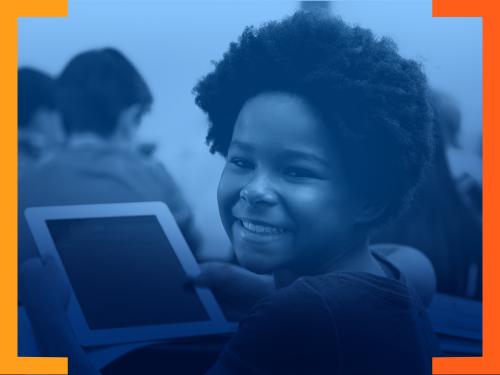A primary revelation during COVID-19 is the importance of digital readiness. While the pandemic is disrupting socioeconomic activities, it is fortunately happening at a time of rapid digitalization. However, differences in digital readiness across and within countries are hindering the ability of large segments of the world to harness digital technology and cope with the pandemic.
This inequality in digital readiness is reflected in Nigeria’s education sector, where learning was disrupted for almost 40 million learners nationwide. The digital infrastructure divide in Nigeria paints a bleak picture for the prospect of distance learning. With only about 40 percent of Nigeria having access to the internet, and 50 percent of the population having limited/no access to the electricity grid, the current prospects of digital technology for education during this crisis are slim. Beyond the infrastructure shortcomings, however, another problem threatens distance learning even more: The digital divide is more than just an infrastructure divide—it is also a literacy divide.
Digital literacy
At a basic level, digital literacy means having the digital-age skills required to effectively use technology and achieve valued output through it. This involves being able to connect to, safely navigate through, and benefit from internet services and applications. More functionally, it involves acquiring the skills that students and job seekers require to meet the needs of the modern digital economy. Investments in infrastructure development are crucial, but they are not a silver bullet; without a comprehensive effort to improve digital literacy through basic education, Nigerians (especially the disadvantaged and vulnerable) will be unable to fully leverage the potential of these investments.
Current basic education framework
Education should prepare students for the demands of work and social life by equipping them with the skills to understand and address the core challenges of the modern era. Unfortunately, the basic education curriculum in Nigeria is not designed to provide students with these skills and knowledge.
The traditional foundation of Nigeria’s basic education system consists of reading, writing, and arithmetic—colloquially known as the 3Rs. This foundation can be traced back to the 19th century, when the early Christian missionaries brought western education into Nigeria. Two centuries later, the skills demand of the world has evolved, and so should Nigeria’s education curriculum.
DRAW: A new framework
The pandemic presents a case for overhauling the basic education curriculum with the aim of adequately preparing the current and next generation of students. The entire 3Rs terminology is obsolete, and should itself evolve too. As a replacement, I propose DRAW: digital literacy, reading, arithmetic, and writing.
- DRAW incorporates digital literacy into the very core of Nigeria’s basic education, and emphasizes it as the channel through which the other three tenets of the curriculum will thrive. It retains the foundation of the 3Rs because, though digital tools are important, they will not be the only tools that students need. Incorporating digital literacy blends the arts and humanities with science, technology, engineering, and mathematics (STEM) fields, ensuring that all students are digitally equipped at the most basic level.
- As a word, DRAW immediately recognizes the importance of engendering an education system that sparks creativity (the highest order of learning), as well as problem-solving, and equips students to understand and express their knowledge in different ways. It provides equal weight to knowledge in the arts, humanities, and STEM fields because it prioritizes digital knowledge as a tool through which students across all disciplines can analyze, create, and communicate their ideas. DRAW ensures that all students are digitally equipped at the most basic level, harnesses technology to amplify the creativity and capabilities of students across all subjects, and enhances career prospects across all sectors/fields.
The ideal DRAW curriculum will be both current and futuristic in its design, and will advance a vision for students’ success in the new global economy. The digital literacy competencies would involve developing—en masse and from a young age—an understanding of the machines and technologies that make the digital age possible. It includes areas such as coding, cybersecurity, machine learning, computational thinking, robotics, and interface design. It is important to note that incorporating digital literacy is not simply about learning technology or digital tools, but involves engaging with the traditional and well-established methods of understanding the world, and developing new insights on its potential impact on traditional core subjects.
The details of this particular framework will require an in-depth analysis of Nigeria’s industrial needs, strengths, weaknesses, opportunities, and financial and teacher qualification requirements to be competitive in the digital global economy. Largely, it will entail synthesizing current global themes (e.g., environmental literacy, global awareness, entrepreneurial literacy, and social and cultural issues), digital literacies, and key life and work skills (e.g., leadership, productivity, initiative, flexibility, and accountability) into the training on traditional subjects to reflect the evolving subject knowledge. This addresses the fact that students will require a different form of knowledge and set of skills than generations before, in order to develop expertise and competitiveness in even the traditional subjects.
COVID-19 and the future of work
The future of work was already changing prior to COVID-19, but the pandemic has accelerated the pace, need, and uptake of technology. It has thrust us further into a digitized world, expediting the transition to the digital age by stimulating both the demand and supply sides of digital technology. Current adaptation strategies to ensure continuity in the worlds of work, schooling, health, and governance are likely to continue even after economies worldwide have successfully reopened and start to recover. There needs to be intentional effort on preparing current and future students to succeed in this changing landscape. With the current curriculum, the average Nigerian student is ill equipped to meet the demands of such a digitized world, and we must begin to draw away from the curriculum of the past.





Commentary
DRAWing away from the curriculum of the past
September 30, 2020